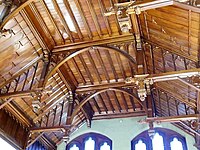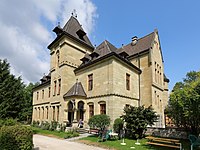Cumberland Castle
The Cumberland Castle was used as a residential palace of Guelph from 1882 to 1886 in historicist built architecture. It is located on a hill northeast of Gmunden near the Traunsee in Austria .
history
On October 2, 1866, the Prussian seizure of the Kingdom of Hanover took place as a result of the German War that Austria and the allied Hanover had lost . As a result of these events, the King of Hanover, George V , had become a landless refugee who was dependent on the hospitality of his relatives and befriended princes. He therefore first went to Vienna to see his war ally, Emperor Franz Joseph I.
Gmunden villas
In the spring of 1868, the royal family and the imperial court in Vienna came to the Salzkammergut for a cure . She stayed in the Villa Redtenbacher (built in 1838 as the classicist Villa Thun ) near Gmunden, which she acquired soon afterwards. The exiled Austria-Tuscany house also settled in Gmunden in the Villa Toscana in 1870 .
The blind King George V died in Paris in 1878 and was buried in the tomb of St. George's Chapel in Windsor Castle . His widow Marie then lived until her death in 1907 in the Gmunden villa, which has been called the Queen's Villa since then and still belongs to the Welfenhaus today.
Residential palace
In 1882 Georg's son, Ernst August, Crown Prince of Hanover and 3rd Duke of Cumberland , bought a lot of land in the immediate vicinity of the Queen's Villa on a hill in the north of the city above the Krottensee in order to have his Windsor-style castle built on it. The Hanoverian Ferdinand Schorbach was commissioned as the architect and designed it in the neo-Gothic Tudor style . After construction began on June 15, 1882, on September 15, 1886, the Welfs moved into the spacious and splendidly furnished palace complex. The castle was intended more to represent than to live. Cumberland Castle is the largest historicist castle in Upper Austria. Red marble from Ebensee, granite from Schärding and sandstone from Regensburg were used as building materials. Great emphasis was placed on the artistic design, and a number of lavishly furnished rooms were created. The world-famous treasures of the Welf Treasure were also kept in the castle. His highlight was the so-called Guelph Bible . The chapel (worth seeing altar paintings from the Lucas Cranach school) and the Prinzenstöckl (today the library building) were built a few years later. From 1886 until his death in 1923 the castle was the seat of the exiled crown prince. Ernst August, his mother and some other members of the family are buried in the mausoleum next to the castle (see below).
The Hanoverians were an important economic factor for Gmunden. Cumberland Castle was a popular meeting place for the European nobility. The court consisted of over 200 people. The ducal family was very involved in cultural and social matters in the city and supported z. B. was instrumental in the establishment of the Evangelical Church in Gmunden (1871-75) and was an extremely generous patron of the city (significant donations for canal and road construction, for the esplanade, for the soup kitchen of the needy, financial support for students and retired soldiers) . The naming of Georgstraße after King George V was one of the signs of the city's gratitude and solidarity with the ducal family.
The associated forest and hunting area near Grünau im Almtal , the Cumberland Wildlife Park , with the Hubertihaus hunting lodge is still owned by a Hanover family foundation .
In 1930 the castle was converted into a Welfish house and family museum. In 1938, the National Socialists took possession of the castle as a Gau training castle . From 1940 to 1945 it served as a military hospital.
Medical use from 1945

After the Second World War , the Republic of Austria took over Cumberland Castle. From 1947 to 1972 the castle served as a TBC hospital. After a thorough disinfection of the building, the castle was rededicated as a state nursing home, and on January 8, 1973, nursing operations were officially started. On January 1, 1979, the entire property passed into the ownership of the State of Upper Austria through purchase and is now called the “State Care and Care Center Castle Cumberland”.
The castle today
The castle was last renovated in 2000 and is often used as a location for filming. Modifications were made to meet the needs of residents and employees, such as installing a lift and locking the numerous chimneys. Since November 1, 2002, Apallics have been cared for in a watch comastation .
The wall-mounted fittings of the castle have largely been preserved and testify to the once magnificent original fittings of the castle. The castle and above all the “state rooms” can be visited occasionally and for specific reasons.
mausoleum
The mausoleum of Cumberland Castle extends below the terrace on the east side of the main building. The complex, which is not accessible to the public, can be entered through a rather inconspicuous-looking access building, which is located on the north side of the castle and is closed by a double-leaf wooden gate. The following members of the House of Hanover are buried here:
- 1. Prince Christian (1885–1901) - son of Crown Prince Ernst August - sarcophagus
- 2. Princess Marie (1849–1904) - daughter of King George V - sarcophagus
- 3. Queen Marie (1818–1907) - wife of King George V - sarcophagus
- 4. Prince Georg Wilhelm (1880–1912) - son of Crown Prince Ernst August - sarcophagus
- 5. Crown Prince Ernst August (1845–1923) - son of King George V - sarcophagus
- 6. Crown Princess Thyra (1853–1933) - wife of Crown Prince Ernst August - sarcophagus
- 7. Princess Olga (1884–1958) - daughter of Crown Prince Ernst August - sarcophagus
- 8. Prince Christian (1919–1981) - son of Prince Ernst August III. - Ash urn
gallery
Cumberland Castle (north side) with English garden
Stone foundation with half-timbering and stair towers
Coffered wooden ceiling with carved wooden supports and round arches
literature
- Karl Piringer: Gmundner Chronicle. 1900-1918. Volume 1. Ed. By Stadtgemeinde Gmunden, undated
- Heinz Schießer : The Welfen at the Traunsee - 130 years of Cumberland Castle. Edited by Heinrich Prinz von Hannover. MatricMedia Verlag Göttingen 2017, ISBN 978-3-946891-02-4 .
- Ingrid Spitzbart: King George V of Hanover and his family in Gmunden exile. In: Gudrun Keindorf and Thomas Moritz (eds.): “Bigger even than Heinrich the Lion.” King George V of Hanover as the builder and identity giver. Edited on behalf of the Friends of the Castle Plesse Association. Accompanying volume for the exhibition of the Göttingen State and University Library in the Paulinerkirche . Mecke Verlag, Duderstadt 2003, ISBN 3-936617-16-3 , pp. 67-80.
Web links
- Internet presence of Castle Cumberland near Gmunden
- Entry via Cumberland Castle to Burgen-Austria
Individual evidence
- ↑ a b c d Cumberland Castle. In: burgen-austria.com , May 11, 2005, accessed April 4, 2018.
- ↑ Schießer, Welfen am Traunsee , p. 34
- ↑ Schießer, Welfen am Traunsee , p. 38.
- ↑ Schießer, Welfen am Traunsee , p. 90.
- ↑ Schießer, Welfen am Traunsee , p. 92.
- ↑ Piringer, Gmundner Chronik , p. 156.
- ↑ Schießer, Welfen am Traunsee , pp. 112–113.
Coordinates: 47 ° 55 ′ 39 ″ N , 13 ° 48 ′ 29 ″ E











